14
Technology of Radio ...As the station grew, more technical staff were needed. Scott Reid began as control operator in the days when the majority of the station's gear was home-made equipment. Scott Reid began hanging around the station after high school. He joined CKNX in 1937 as a controlman and announcer, but soon graduated to chief engineer. 'Radio has always been a natural for Scott - even as a youngster he played constantly with crystal sets and performed complicated operations and post mortems on whatever sets were not locked up."(CKNX Almanac, 1942) Just out of the RCAF after a four-year tour of duty, one of his first tasks shortly after he was appointed chief engineer was to design and install new equipment in an entirely revised studio set-up. This task was completed in 1946. Since that time it has been completely re-designed once, and re-wired twice. Scott estimates, there are 17 miles of wire running under the main control room. (OST-22, 1955, p. 5)
Literally every piece of electronic equipment used in the station's service was either built from scratch or remodeled by Scott Reid. Scott Reid's "systems were imaginative and he was far ahead of his time in developing equipment to meet the demands of the growing station. Whether it was remote amplifiers for church broadcasts, sound systems for fall fairs and the Barn Dance or the sophisticated Master Control Room for the studios, Scott was the man who made it all work." (Bob Carbert essay)
15
The radio control room of CKNX in 1938.1938
920 CKNX, Wingham, Ontario
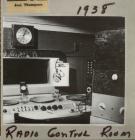 Credits:
Credits:Wingham Library, Wingham, Ontario
Wingham Professional Businesswomen's Association
16
Jack Caesar in audio with John Krug in the control room of CKNX1950s
CKNX Radio and Television building, Carling Terrace, Wingham, Ontario
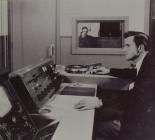 Credits:
Credits:North Huron Museum, Wingham, Ontario
17
CKNX's "raison d'etre" ...News has always been the "raison d'etre" for CKNX radio. With a large proportion of CKNX listeners located on farms and small villages, news was a vital link to the communities. Some towns had weekly papers and few stores brought in the London and/or Toronto daily newspapers. Phones were common in the towns within CKNX's broadcasting community, but not all farms were connected yet. The Depression had stalled the advance of modern wonders like phones, electricity and indoor plumbing. But radio was catching on. With the transformation of 10BP into CKNX, a need for a news gathering program arose.
Enter Harry J. Boyle ...
In 1981, Harry J. Boyle, a St. Augustine farmboy, recounted his beginnings at CKNX for the Village Squire - "By 1933 jobs were hard to find. In fact, it was almost impossible and when you found one, the man next to you on the construction job, could have an M.A. It was most discouraging. For me it was also a period of trying to write and having a small success. Then by sheer change, I had the opportunity to do some reporting with the London Free Press and two of the Toronto papers. Enthusiasm and necessity brought the name of the town of Wingham to many pages of newsprint.
While boarding with the Clayton Frys, (Boyle was in Wingham to cover a murder trial) I became aware of CKNX. I decided to approach Doc Cruickshank. He listened to my 'pitch' about carrying local news on his station, listened to me on the microphone and hesitated. The 'pitch' continued and after a consultation with Howard Bedford, he said, "okay you can try out but we won't be able to pay you anything." After two weeks however, and by dint of hard work and the response of enough loyal relatives, I managed to make enough impression to get a 'token' salary. "They were using the old Christian Science Monitor service those days," said Mr. Boyle. It was broadcast from the United States and picked up independently by a stylus. It usually came in several days later. "I said, hell, I can do a better job than that," Doc let him go ahead on a trial basis but after a week Mr. Boyle told him he was losing money by working for no money.
Boyle worked at CKNX organizing the news gathering system and doing news announcement from 1935 to 1941. He began doing fifteen minute 'local' newscasts and soon was a full-time employee broadcasting a noon hour program that included local news, an agricultural report with local agricultural reps from the community, entertainment notices, upcoming meetings, births, deaths and any other information important to the large rural listening area. From then on Doc paid Mr. Boyle $3 a week. (LFP-5, 1970) "Yes, Harry set up our news service with correspondents," recalled Doc, " We knew what had to be done but Harry knew how to do it and did it." (LFP-5, 1970)p.1
Boyle left in 1941to work for the Stratford Beacon Herald. He went on to work at the CBC and the Canadian Radio Television Commission. He also wrote a number of radio plays and books.
18
Harry J. Boyle worked at 920 CKNX from 1935 to 1941as a news announcer.1970s
CKNX Television & Radio station, Wingham, Ontario
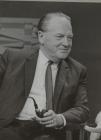 Credits:
Credits:North Huron Museum, Wingham, Ontario
19
This letter describes Harry J. Boyle's experience working at CKNX radio as a news announcer.1935-1941
920 CKNX, Wingham, Ontario
 Credits:
Credits:Wingham Library, Wingham, Ontario
Wingham Professional Businesswomen's Association
20
Harry J. Boyle describes his experience at CKNX as a newscaster between 1935-1941.1935-1941
920 CKNX, Wingham, Ontario
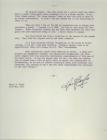 Credits:
Credits:Wingham Library, Wingham, Ontario
Wingham Professional Businesswomen's Association
21
News ...When Harry J. Boyle left CKNX in 1941 to pursue a writing career with the Stratford Beacon-Herald, he was succeeded at CKNX by Hugh Gage, an experienced newsman and fine violinist (A Story of CKNX and its People, 2008). Goldie Buckingham took over after Hugh Gage. Buckingham left to operate a weekly paper in Kincardine and was replaced by John Strong, who arrived from CKPC, Brantford.
John Strong sent up a network of local correspondents all over the CKNX listening areas. News reports soon began to flow in from "Lobby" Lobsinger in Walkerton, "Cueball" McConnell in Goderich, Maud Heddon in Hensall, Muriel Trott in Clinton, Cy Bamford in Listowel, Elgin Fraser in Kincardine and others during the 1940s keeping CKNX on top of the news.
In the case of the Langton bank hold-up in the summer of 1950 - a tip from one of the CKNX news correspondents enabled CKNX, 100 miles away from the scene, to broadcast news of the Langton robbery while the robber was driving away from the bank with his loot. The resulting story gave listeners full coverage on the gun-battle and capture of the murderer-as he turned out to be. (25th Anniversary, 1951)
Through CKNX listeners got action. According to an article in the CKNX Almanac in 1943, an announcement was put on the air asking for the police to aid them in the apprehension of thieves who broke into a store in the north. Within ten minutes, Constable Gardiner 'phoned us to tell us they (the thieves) were in custody. Talk about results!' (CKNX Almanac-10, 1943)p.4
Early News Service ...
In the early days before the broadcast news wire service was available, the only source of outside news was a ticker-tape facility that contributed reports in morse code that had to be deciphered into English. That and the daily newspaper formed those early news sources along with volunteer local reporters. (Carbert essay, 1995 p.9) During World War II, CKNX used a Transradio Press Ticker to get news stories from the world's many battlefields - Cairo, London, Washington, Ottawa, Stockholm (CKNX Almanac-4, 1942, p.5) In 1942, CKNX installed a brand new news machine. The news ticker (Egfoo as we affectionately used to call it) will go the way of all good things with the date of this issue when the new British United Press Teletype is installed. You'll have to drop in and pay respects to the little gem and watch the news items fall thick and fast. (CKNX Almanac-5, 1942) p.4
22
Original news desk of Harry J. Boyle1935-1941
920 CKNX, Wingham, Ontario
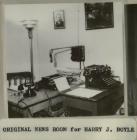 Credits:
Credits:Wingham Library, Wingham, Ontario
Wingham Professional Businesswomen's Association
23
Expansion ...In 1937, CKNX got permission to step up the power from 50 to 100 watts. At this point the staff increased to 7 members. "It was then that the community service policies of the station were laid down. It was quite evident that to survive, programs had to be geared to the needs of the listener." All news - no matter what was going on in the world - was to have a 50% local content. Talent, wherever possible was to be live and local. (25th Anniversary, 1951)
Funeral Announcements - CKNX pioneered another service that originally caused some eye-brows to lift, but it quickly became the most listened-to show on the station, and it remains so today. "Funeral Announcements" began in those early days of CKNX and to this day remains one of the few programs as a station service without a commercial sponsor. (Carbert essay, 1995) p. 14
Public Services - The funeral directory was only one of a multitude of public services offered by CKNX Radio, weather reports, road advisories, school closings, meeting announcements and postponements, fairs and plowing matches. Service clubs were the recipients of many free-time donations, such as the Kinsmen's Radio Auction, the Salvation Army's Red Shield fund raising drive. In fact, on more than one occasion Doc Cruickshank served as co-ordinating chairman of that Red Shield Drive. But perhaps the most extensive and widely recognized public service was the provision of a mobile public address system for local fairs and exhibitions. This started in the mid-40s, and consisted of the station providing a mobile P.A. system, mounted on the roof of one of the station vehicles, parked in the center of the fair grounds, so the sound could be heard in every corner. Tory Gregg became one of western Ontario's best known personalities by acting as Master of Ceremonies - Race Starter, at a host of fall and spring fairs, and Elmer Purdon, who had for years been the unseen and unheralded technical operator for the Saturday night Barn Dance, became a fixture with this mobile unit. In the mid 50s when Tory accidentally found himself double-booked for several dates I(Bob Carbert) was pressed into service with a back-up sound system and for as long as I remained at CKNX I continued to serve in this capacity at a dozen or so annual fairs.
In more recent years, CKNX became very well known for its service to the International Plowing Match, providing the mobile sound system and message service throughout the "Tent City". These services were carried out by Pete Hollinger, and especially by Roy Bennett, who served the station and the public well for many years. (Carbert essay, 1995) p. 14
24
Radio announcer, Doug Fry, at the radio master control panel in the CKNX radio stationcirca 1946
920 CKNX, Wingham, Ontario
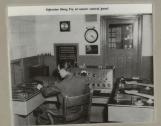 Credits:
Credits:North Huron Museum, Wingham, Ontario
25
More Power ...During the year 1940, when CKNX was endeavouring to get an increase in power and a better wave length, Mr.Robert Deachman, who was then Federal member for North Huron, arranged for many interviews with radio authorities. (25th Anniversary, 1951) The push for more power was ultimately successful. In 1941, a new 100 watt transmitter and antennae were installed on Highway 4, south of Wingham. (MM, 159) When permission was granted to increase power to 1,000 watts, the station's popularity grew in this expanded broadcast area, largely because of its use of live talent, and the 'Barn Dance' was perhaps the finest example of this. (Carbert essay, 1995)p.2f
By 1941, Wingham was calling itself "The Radio Town of Canada." CKNX staff numbered 13. Gross revenue was $27,000. A down payment on the new 1,000 watt transmitter was made. (100yrs, 22) The station became a full-time job for Doc and he operated from a room in the Brunswick Hotel, a structure no longer standing. (LFP-5, 1970) "By 1941 revenue had reached $27,000 a year. Doc managed to save $2,200 and it served as a downpayment to RCA Victor who took a chance on the small-town entrepreneur and installed a new $30,000 transmitter. A piece of land was purchased a few miles south of town for the transmitter site. A transmitter house was built. Studios were enlarged and modernized. When the commercial license was gained the station had jumped in power from 50 to 100 watts. Now the jump was to be to 1000 watts and the frequency was to change from 1200 at one end of the dial to 920 kilocycles at the middle of the dial. (50 years, 1976, p.6) (VS-1, 1976)
The studios were enlarged and hundreds of smaller improvements added until the cost ran up to around $30,000. (25th Anniversary, 1951)
The studio was redone - there was a green tile front put on the CKNX station. The main studio lives up to the promise of the 'gay front and the guests are inevitably delighted with the well-appointed station. When in Wingham, plan on a half hour or fifteen minutes to be spent with the CKNX staff." (CKNX Almanac-5, 1942 p.5)
26
Exterior of CKNX on Josephine Street, Wingham - circa 1940s1940s
Original radio station, Josephine Street, Wingham, Ontario
 Credits:
Credits:North Huron Museum
27
Interior of the original radio station located on Josephine Street, Wingham, Ontario1930s
Original radio station, Josephine Street, Wingham, Ontario
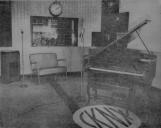 Credits:
Credits:North Huron Museum, Wingham, Ontario